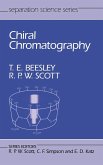Das weltweite Interesse an der Trennung von Enantiomeren, Spiegelbildern ein und derselben chemischen Verbindung, nimmt zu, da diese Formen beispielsweise verschiedene physiologische Wirkungen hervorrufen können. Eine hochaktuelle Technik der Stofftrennung in diesem Zusammenhang ist die Kapillarelektrophorese, die hier von den theoretischen Grundlagen bis hin zu analytischen Details und Anbieterlisten ausführlich beschrieben wird. Electrophoretic techniques are used to separate large charged molecules such as proteins and sugars. Capillary electrophoresis (CE) allows separation on a very small scale: chiral analysis is the separation of different molecules that are mirror images of one another.
Capillary Electrophoresis in Chiral Analysis Bezhan Chankvetadze Tbilisi State University, Republic of Georgia The application of capillary electrophoresis (CE) to the field of chiral analysis has exploded recently. The advantages of capillary electrophoresis - extremely high peak efficiency, excellent compatibility with biological samples, short analysis time, simplicity, versatility and low cost - are perfect for the accurate measurement of optical purity, increasingly important in the regulation-ruled pharmaceutical industry. Although there have been a number of books on capillary electrophoresis and chiral analysis separately, as yet there has been no dedicated monograph on the application of capillary electrophoresis to chiral analysis. This book bridges the gap. Capillary Electrophoresis in Chiral Analysis charts the evolution of chiral capillary electrophoresis and describes new types of chiral selectors and mechanistic aspects of chiral recognition. While on the one hand,it is an excellent introductionto newcomers, on the other, it is of practical use to experienced researchers in the field wishing to solve a particular separation problem. It includes an alphabetical list of chiral compounds resolved using CE with appropriate references, which any one working in the field will find invaluable.
Capillary Electrophoresis in Chiral Analysis Bezhan Chankvetadze Tbilisi State University, Republic of Georgia The application of capillary electrophoresis (CE) to the field of chiral analysis has exploded recently. The advantages of capillary electrophoresis - extremely high peak efficiency, excellent compatibility with biological samples, short analysis time, simplicity, versatility and low cost - are perfect for the accurate measurement of optical purity, increasingly important in the regulation-ruled pharmaceutical industry. Although there have been a number of books on capillary electrophoresis and chiral analysis separately, as yet there has been no dedicated monograph on the application of capillary electrophoresis to chiral analysis. This book bridges the gap. Capillary Electrophoresis in Chiral Analysis charts the evolution of chiral capillary electrophoresis and describes new types of chiral selectors and mechanistic aspects of chiral recognition. While on the one hand,it is an excellent introductionto newcomers, on the other, it is of practical use to experienced researchers in the field wishing to solve a particular separation problem. It includes an alphabetical list of chiral compounds resolved using CE with appropriate references, which any one working in the field will find invaluable.








